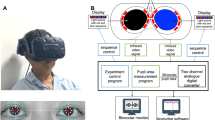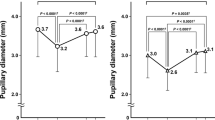Abstract
Purpose
We evaluated the effects of pseudoexfoliation syndrome on dynamic, static pupillary parameters (scotopic, mesopic, photopic) and the pupil dilation speed, with automatic pupillometry.
Material and methods
The study group included 140 eyes with clinically visible pseudoexfoliation material (PXM) of 110 patients. The study group was compared with the control group formed by including 140 eyes of 110 patients. Scotopic measurements at 0.4 lx illumination, mesopic measurements at 4 lx illumination, and photopic measurements at 40 lx illumination were performed. Dynamic measurements were made at 500 lx illumination. The mean pupil dilation speed at 10th second was calculated. In addition, the eyes (80 patients) with clinically unilateral PXM were compared with the other eyes of the patients.
Results
The mean scotopic, mesopic, photopic and dynamic pupil diameters of eyes with clinical PXM were compared with the control group, all values were found to be significantly lower in eyes with PXM. (p < 0.0001, p < 0.0001, p < 0.0001, p < 0.0001, respectively). The mean speed of pupil dilation at the 10th second was also significantly lower in the pseudoexfoliation syndrome group (p < 0.0001). The measurement results of the patients with clinical PXM were significantly lower than the other unaffected eyes (p = 0.001, p = 0.004, p = 0.048, p = 0.035, respectively). The mean speed of pupil dilation at 10th second was also significantly lower in eyes with PXM (p = 0.009).
Conclusion
Results clearly reveal that pseudoexfoliation syndrome affects iris mechanisms. Although pseudoexfoliation syndrome is a systemic syndrome, we can say that the emergence of iris dysfunction findings is parallel with the clinical observation of PXM.
Similar content being viewed by others
References
Ariga M, Nivean M, Utkarsha P (2013) Pseudoexfoliation syndrome. J Curr Glaucoma Pract 7(3):118–120
Aboobakar IF, Johnson WM, Stamer WD, Hauser MA, Allingham RR (2017) Major review: exfoliation syndrome; advances in disease genetics, molecular biology, and epidemiology. Exp Eye Res 154:88–103
Tuteja S, Chawla H. Pseudoexfoliation Syndrome. 2021.
Parekh P, Green WR, StarK WJ et al (2008) Electron microscopic investigation of the lens capsule and conjunctival tissues in individuals with clinically unilateral pseudoexfoliation syndrome. Ophthalmology 115:614–619
Tekin K, Sekeroglu MA, Kiziltoprak H, Yetkin E, Doguizi S, Yilmazbas P (2018) Static and dynamic pupillary characteristics in clinically unilateral pseudoexfoliation syndrome. J Glaucoma 27(6):552–557
Yülek F, Konukseven OO, Cakmak HB, Orhan N, Simşek S, Kutluhan A (2008) Comparison of the pupillometry during videonystagmography in asymmetric pseudoexfoliation patients. Curr Eye Res 33(3):263–267
Tekin K, Kiziltoprak H, Sekeroglu MA, Yetkin E, Bayraktar S, Yilmazbas P (2020) Static and dynamic pupil characteristics in pseudoexfoliation syndrome and glaucoma. Clin Exp Optom 103(3):332–338
Yasar E, Yildirim N, Atalay E, Tambova E, Colak E (2017) Pupillometry as a screening tool to detect pseudoexfoliation syndrome. Optom Vis Sci 94(7):770–774
Winston M, Zhou A, Rand CM, Dunne EC, Warner JJ, Volpe LJ et al (2020) Pupillometry measures of autonomic nervous system regulation with advancing age in a healthy pediatric cohort. Clin Auton Res 30(1):43–51
Bista Karki S, Coppell KJ, Mitchell LV, Ogbuehi KC (2020) Dynamic pupillometry in type 2 diabetes: pupillary autonomic dysfunction and the severity of diabetic retinopathy. Clin Ophthalmol 14:3923–3930
Öztürk Y, Yıldız MB, Bolaç R (2021) Evaluation of pupillometric parameters in patients with COVID-19. Ocul Immunol Inflamm 23:1–5
de Vries L, Fouquaet I, Boets B, Naulaers G, Steyaert J (2021) Autism spectrum disorder and pupillometry: a systematic review and meta-analysis. Neurosci Biobehav Rev 120:479–508
Schlötzer-Schrehardt U, von der Mark K, Sakai LY, Naumann GO (1997) Increased extracellular deposition of fibrillin-containing fibrils in pseudoexfoliation syndrome. Invest Ophthalmol Vis Sci 38(5):970–984
Yiğit U, Onur IU, Tufan AK et al (2015) Assessment of pupil diameters in pseudoexfoliation syndrome under scotopic, mesopic, photopic and dynamic conditions using infrared pupillometer. BJMMR 7:877–883
Funding
The authors declare that no funds, grants, or other support were received during the preparation of this manuscript.
Author information
Authors and Affiliations
Contributions
GYB was responsible for the study design, data collection and analysis, writing of the manuscript and creation of the figures. KRZ and GYB were responsible for parts of the data collection. KRZ was responsible for manuscript review. The final version was of the manuscript was approved by all authors.
Corresponding author
Ethics declarations
Competing interests
The authors declare no competing interests.
Conflicts of interest
No Conflicts of Interest: All authors certify that they have no affiliations with or involvement in any organization or entity with any financial interest (such as honoraria; educational grants; participation in speakers’ bureaus; membership, employment, consultancies, stock ownership, or other equity interest; and expert testimony or patent-licensing arrangements), or non-financial interest (such as personal or professional relationships, affiliations, knowledge or beliefs) in the subject matter or materials discussed in this manuscript.
Ethical approval
This retrospective study was performed in line with the principles of the Declaration of Helsinki. Approval was granted by the Ethics Committee of Niğde Ömer Halisdemir University. All procedures performed in studies involving human participants were in accordance with the ethical standards of Niğde Ömer Halisdemir University.
Consent to participate
Written informed consent was obtained from the parents.
Informed consent
The authors certify that they have obtained all appropriate patient consent forms. In the form, the patient(s) has/have given his/her/their consent for his/her/their images and other clinical information to be reported in the journal. The patients understand that their names and initials will not be published and due efforts will be made to conceal their identity, but anonymity cannot be guaranteed.
Additional information
Publisher's Note
Springer Nature remains neutral with regard to jurisdictional claims in published maps and institutional affiliations.
Rights and permissions
Springer Nature or its licensor (e.g. a society or other partner) holds exclusive rights to this article under a publishing agreement with the author(s) or other rightsholder(s); author self-archiving of the accepted manuscript version of this article is solely governed by the terms of such publishing agreement and applicable law.
About this article
Cite this article
Yıldırım Biçer, G., Zor, K.R. How are pupillary parameters affected in pseudoexfoliation syndrome? A quantitative study. Int Ophthalmol 43, 2487–2491 (2023). https://doi.org/10.1007/s10792-023-02648-8
Received:
Accepted:
Published:
Issue Date:
DOI: https://doi.org/10.1007/s10792-023-02648-8




